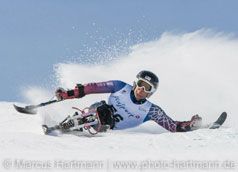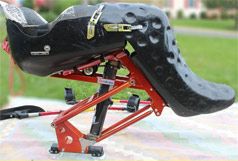When you watch Tyler Walker race down a mountain, you can’t help but notice his form. Walker, a member of the U.S. Adaptive Ski Team and the 2014 U.S. Paralympic Alpine Skiing Team, is able to tilt his ski at an extreme angle as he maneuvers around gates.
“Tyler’s ski and the frame bank up to about an 80-degree angle, but his torso is still almost vertical,” says Joachim Grenestedt, professor of mechanical engineering and director of Lehigh's Composites Lab.
Walker most recently placed third in the super-combined, downhill 1 and downhill 2 races in the IPC NorAm Cup in Kimberly, British Columbia. He also placed first and third in the two giant slalom races in the IPC 2015 World Cup Finals in St. Moritz, Switzerland. He did so using a monoski of Grenestedt’s design.
Grenestedt’s desire to make things better and faster has led him to put his stamp on land speed racers, boats and aircraft. He turned his attention to monoskis when a former student was injured in an accident and lost the use of his legs. An avid skier himself, Grenestedt encouraged the student to try adaptive skiing.
“I’d seen a lot of these adaptive skiing programs and it is truly amazing what some people can do. Skiing is a high-adrenaline outdoor sport with lots of action and I love it,” says Grenestedt.
While observing his former student on a monoski for the first time, Grenestedt noticed that a large number of monoskis at the lodge were broken.
“I believed we could design and manufacture a better sled,” says Grenestedt. The speed-loving engineer saw a challenge. He worked with Lehigh mechanical technician Bill Maroun to build a better monoski. The first one went to the student, who used it for several years. Grenestedt and Maroun’s ski caught the attention of other skiers because it never broke.
In 2011, Grenestedt and his wife, Channy Tokura, received a Technology Transfer Grant from the Keystone Innovation Zone (KIZ) and started DynAccess, an adaptive ski equipment company whose slogan is “Nature has no sidelines.” Tokura runs the business, while Grenestedt serves as the self-proclaimed “grease monkey.” Word traveled fast in the small and close-knit community of adaptive skiing.
DynAccess monoskis feature a stiff, strong frame, specially developed suspension geometry and custom-made shock absorbers, among other high-quality elements. The company collaborates exclusively with Penske Racing Shocks, a high-tech Reading, PA-based company that makes what Grenestedt calls the best shock absorbers in the world. Penske supplies racing shocks to Indy Car, Formula One and NASCAR teams.
This connection is particularly appropriate, as Grenestedt sees monoskis as vehicles: “These are racecars and I’m making these racecars go faster and with better precision.”
The athletes agree.
“The frame moves in a very predictable way,” says Walker. “It’s very light. It’s very strong. A lot of thought went into the frame, and the shock absorber really makes everything work. I’ve been using his monoski since last summer, and every time I use it I find something new. It gets better and better and I’m starting to realize how much it’s going to let me improve.”
Read the full story at the Lehigh University News Center.
-Kelly Hochbein is a writer with Lehigh University Media Relations.



